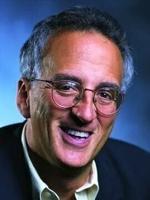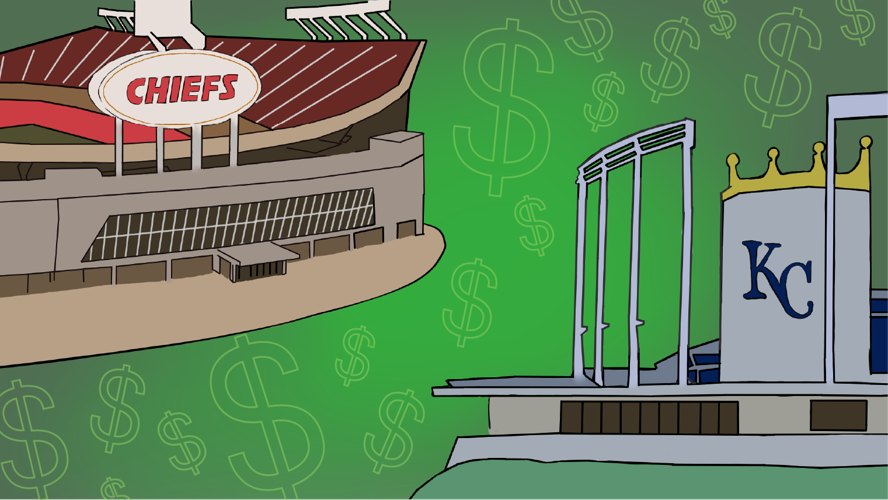
Illustration by Yasha Mikolajczak/Missouri ĐÔĘӽ紫ý Alert
The Kansas City Chiefs and Royals are in the batterĐÔĘӽ紫ý™s box of sorts.
With new, fully renovated professional sports stadiums , both teams play in venues that are among the oldest in their leagues. Missouri passed a law to help fund stadium renovations for the Chiefs and construction of a new home for the Royals. Kansas, too, has proposed incentives for the teams to build stadiums. That offer is set to expire Monday, but the Chiefs have requested an extension.
Ultimately, the teams will select pitches.
In Kansas City and around the country, the impact on local economies has been a prominent topic in discussions about financing professional sports stadiums. These major infrastructure projects now regularly cost upward of a billion dollars, and they often rely on some amount of public funding.
Most economists say sports venues do not have a net positive impact on local economies. However, that calculation can be affected by a variety of factors, including how stadiums are financed and what development accompanies them.
Assessing economic impact
Victor Matheson, a sports economist at the College of the Holy Cross, is among the many economists who said sports teams provide little to no net economic benefit to their home markets.
Matheson cites a ĐÔĘӽ紫ýśsubstitution effectĐÔĘӽ紫ýť as a main reason for this. For example, a family can choose to spend disposable income going to a concert, instead of a Royals game, and it still has a similar effect on the local economy. And if the Royals ceased to play in Kansas City, the money fans spend on the team would end up being spent somewhere else in the local economy.

Andrew Zimbalist
ĐÔĘӽ紫ýśOne more person spending their entertainment dollars on the Royals is a person whoĐÔĘӽ紫ý™s not downtown eating fantastic Kansas City ribs instead,ĐÔĘӽ紫ýť Matheson said.
Andrew Zimbalist, an economist at Smith College, who has published more than a dozen books about the economics of sports, said, as a broad generalization, stadiums are not tools of economic development.
ĐÔĘӽ紫ýśThey donĐÔĘӽ紫ý™t promote economic growth in a city,ĐÔĘӽ紫ýť Zimbalist said.
However, he said the economic benefits of stadiums can vary considerably depending on a number of variables.
ĐÔĘӽ紫ýśWhether or not thereĐÔĘӽ紫ý™s an economic return to the city depends on the details of the deal,ĐÔĘӽ紫ýť he said.
Zimbalist said the way stadiums are financed, what tax incentives they receive and how revenue they generate is split between teams and governments all affect their impact on the local economy.
Shifts in public funding
Public money and professional stadiums have been symbiotic since the inception of professional stadiums. Over $10.6 billion in public money has been spent on current NFL stadiums alone, , a professor at Westmont College who researches the politics of sports. All but four stadiums in the league have received some form of public money, whether it was for construction projects or renovations. Knecht calculates the total costs of current NFL stadiums, accounting for inflation and renovations, is $33 billion.
Last year, more than $13 billion in taxpayer subsidies were proposed by various teams in professional sports for new construction and renovations across the country, , a nonpartisan tax policy organization.
However, the share of stadium costs taxpayers subsidize has waned in recent years, according to by economists John Charles Bradbury, Dennis Coates and Brad Humphreys.
Their research suggests the U.S. is , and there is potential for substantial costs to taxpayers ĐÔĘӽ紫ýśif the current practice of heavily subsidizing stadiums persists, especially as construction costs and public contributions continue to escalate.ĐÔĘӽ紫ýť
They report that stadiums opened or planned in the 2020s have received roughly 40% of their funding from public money, which is less than at any time since the 1920s. In the last stadium boom, during the 1990s and 2000s, the public share of stadium construction was just above 70%.
The state incentives recently would finance about half the costs of renovating Arrowhead and building a new Royals ballpark. A plan could cover up to 70% of the costs of new stadiums for the teams.
The T-Mobile center in Kansas City, which opened in 2007 as the Sprint Center, received public money. It was a partnership between the city and Anschutz Entertainment Group, which also has stakes in venues like Arena in Los Angeles and The O2 in London.
Construction of the Kansas City arena , and most of it was financed through more than $233 million of bonds the city issued.

The Kansas City arena, now called the T-Mobile Center, benefited from public subsidies when it was built.
The rise of stadium districts
Entertainment districts that include restaurants, bars, event centers and more have become a popular pairing with stadiums and arenas over the past 25 years.
Since 2000, many franchises have added their own versions around their home sites. Examples include The Battery at Truist Park, the new home of the Atlanta Braves, and Titletown near Lambeau Field, the PackersĐÔĘӽ紫ý™ stadium in Green Bay, Wisconsin.
In St. Louis, Ballpark Village was planned along with Busch Stadium, the CardinalsĐÔĘӽ紫ý™ downtown home. After the stadium opened in 2006, the first phase of the entertainment district debuted in 2014, featuring 150,000 square feet of bars and restaurants. A second phase, with office and residential space, a hotel and retailers, opened starting in 2020. From 2006 to 2022, the an average of nearly $13 million in local taxes and over $20 million in state taxes annually.

Ballpark Village, a mixed-use development in downtown St. Louis, was constructed around Busch Stadium, which opened in 2006.
Kansas CityĐÔĘӽ紫ý™s Power & Light District, owned by Baltimore-based developer the Cordish Companies, is another example of these entertainment districts. Opened in early 2008 after the fall 2007 debut of the Sprint Center, it features bars, restaurants and KC Live, an open-air event space.
, the local tourism and convention group, the downtown arena was the anchor to more than $8 billion of redevelopment in downtown Kansas City and has generated more than $1 billion in economic impact since its debut.
But John Charles Bradbury argues such spending comes at the expense of other local businesses. The economist, who co-authored the paper about public subsidies for stadiums, also about the mixed-use districts that increasingly accompany sports venues.
ĐÔĘӽ紫ýśCustomers patronizing external development vendors are doing so at the expense of other local businesses, which means no net enrichment of the community or its treasury,ĐÔĘӽ紫ýť he wrote.




